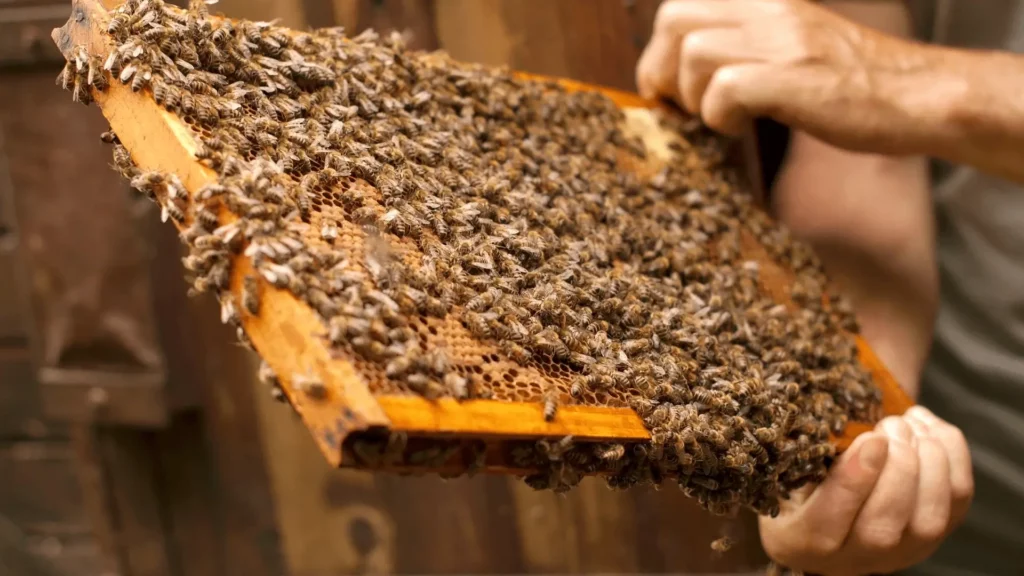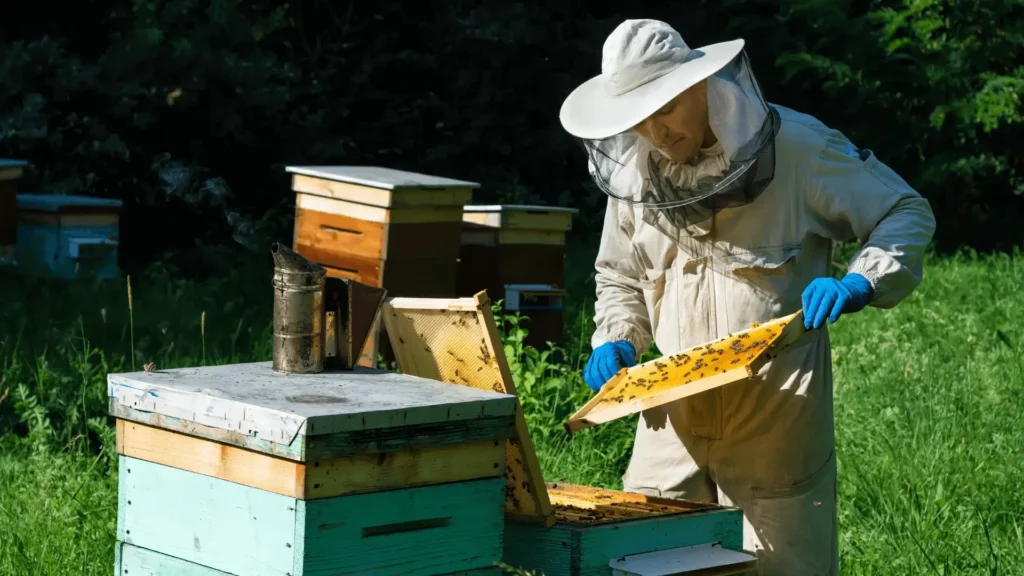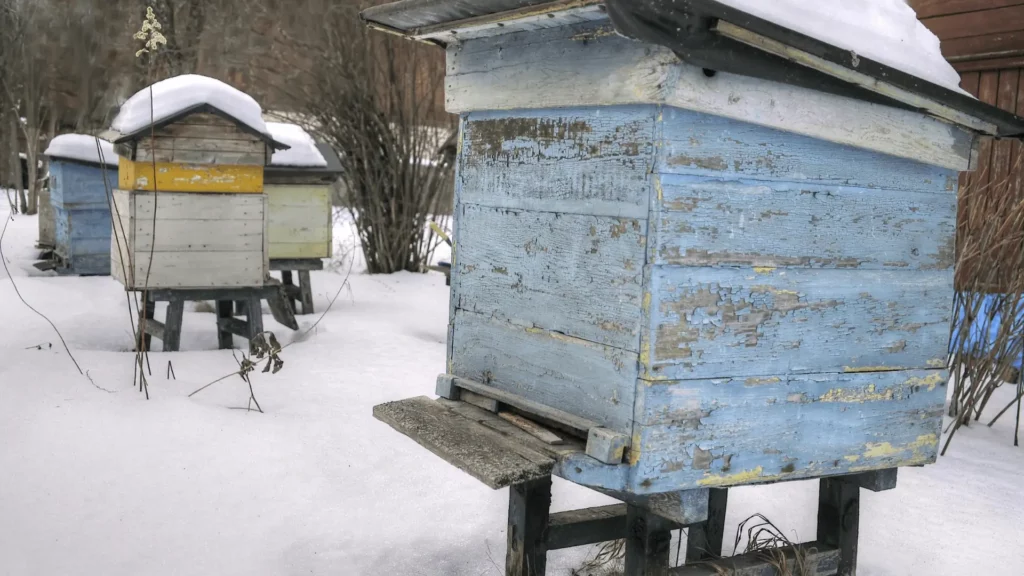
Are you a beekeeper pondering the right hive for your apiary? Have you considered the possibilities of a horizontal beehive? Horizontal beehives offer a unique approach to beekeeping that differs from the more commonly used vertical beehives. If you’re curious about the advantages and disadvantages of horizontal hives, different types available, and the differences between horizontal and vertical hives, you’ve come to the right place.
In this article, we’ll dive into the world of horizontal beehives and explore their distinctive features and differences compared to their vertical counterparts. We’ll discuss the pros and cons, the various types of horizontal hives, and their suitability for different beekeeping scenarios. Whether you’re a new beekeeper looking for the best hive style or an experienced beekeeper searching for an alternative, this guide will provide the essential insights you need to make an informed decision.
Keep reading to discover the fascinating world of horizontal beehives and find out if they’re the right fit for your apiary.
Introduction to Horizontal Beehives: A Unique Beekeeping Approach
Horizontal beehives offer beekeepers a unique approach to managing their honey bee colonies. Unlike the more common vertical beehives, which are stacked in multiple hive boxes, horizontal beehives consist of a single, elongated box. This alternative style of hive has gained popularity among beekeepers for several reasons.
The appeal of horizontal beehives lies in their practicality and simplicity. With a horizontal setup, beekeepers can avoid the heavy lifting associated with vertically stacked hives. Instead of maneuvering multiple boxes, the beekeeper only needs to manipulate a single long hive. This minimalist approach not only reduces strain on the beekeeper but also provides a more ergonomic solution for the bees themselves.
Another advantage of horizontal beehives is the ease of brood nest manipulation. In a vertical hive, accessing the brood chamber may involve disassembling multiple boxes. With a horizontal hive, the entire brood nest is easily accessible, allowing for efficient inspection and management.
Additionally, honey extraction becomes a simpler task in horizontal beehives. The elongated design often incorporates frames that can be easily removed and inspected, making the process of harvesting honey more convenient for beekeepers.
Overall, horizontal beehives offer a practical and efficient alternative for beekeepers who prefer a more hands-on approach. The unique design provides a streamlined system for management and maintenance, making it an attractive option for both new beekeepers and experienced apiarists looking for a change.
Honey Bees in Vertical or Horizontal Hives
When it comes to beekeeping, one important decision to make is whether to keep honey bees in vertical or horizontal hives. Each option has its own unique benefits and considerations. Let’s delve into the differences and advantages of a horizontal hive setup.
Horizontal Hives: A Natural Approach
Horizontal hives offer a more natural environment for honey bees compared to vertical hives. In a horizontal hive, the bees build their comb horizontally, mimicking the structure of a wild colony’s nest. This horizontal orientation aligns with the bees’ natural instincts and allows them to exhibit their behaviors more freely.
Improved Brood Nest Manipulation
One significant advantage of horizontal hives is the ease of manipulating the brood nest. Beekeepers can access the brood chamber from the sides, eliminating the need to lift heavy boxes as required with vertical hives. This minimizes the stress on the bees and the beekeeper, making inspections and brood management less physically demanding.
Enhanced Honey Extraction
Horizontal hive setups also facilitate honey extraction. With a horizontal hive, the honey frames are arranged side by side, making it simpler to remove and process honey. Beekeepers can extract honey without disturbing the brood chamber, resulting in less disruption to the colony and maintaining brood temperature and development.
Better Thermal Regulation
Horizontal hives inherently offer better thermal regulation for the bees. Since heat rises, a horizontal hive configuration allows for easier temperature control, with warm air naturally circulates throughout the hive. This helps the bees maintain the optimal temperature for brood development, reducing the workload on the colony.
Types of Horizontal Beehives
In the world of beekeeping, horizontal beehives offer a unique and alternative approach. Let’s explore the different types of horizontal beehives, including top bar and horizontal Langstroth hives, and delve into their distinct features and uses.
Top Bar Beehives
Top bar beehives are designed with horizontal bars that serve as the foundation for the bees to build their comb. These hives focus on replicating the natural behavior of bees, allowing them to create natural-sized cells and freely build comb in their preferred direction. Here are some key features of top bar beehives:
– Simplified Design: Top bar hives have a minimalist approach, often consisting of a single box with bars running across the top.
– Easy Maintenance: The lack of standard frames and fixed comb provides beekeepers with greater ease in hive inspection and maintenance.
– Hive Manipulation: Beekeepers can easily manipulate the brood nest and manage the colony by removing or adding bars as needed.
– Natural Comb Building: Bees can build their comb according to their own natural instincts, resulting in the creation of cells that cater to their specific needs.
These hives are especially popular among beekeepers looking for a more hands-on and sustainable approach that closely mimics the bees’ natural habitat.
Horizontal Langstroth Beehives
The horizontal Langstroth hive is a variation of the traditional vertical Langstroth hive. Instead of stacking supers vertically, these hives feature boxes designed to be arranged horizontally. Here’s what you need to know about horizontal Langstroth beehives:
– Familiarity with Langstroth: If you’re already familiar with the vertical Langstroth hive, transitioning to a horizontal version allows for an easier adjustment.
– Easy Accessibility: With side-by-side frames, beekeepers have better access to the brood nest and can perform hive manipulations with less heavy lifting.
– Honey Extraction: Extracting honey is simplified as the frames can be removed horizontally, making the process more efficient and less disruptive to the bees.
Horizontal Langstroth beehives offer a compromise between traditional vertical hives and the benefits of horizontal beekeeping. They are particularly suitable for beekeepers who appreciate the convenience and flexibility of Langstroth hives but prefer the advantages of a horizontal setup.
Both top bar and horizontal Langstroth beehives provide beekeepers with unique options for their apiaries. Understanding the features and uses of these different types of horizontal beehives allows beekeepers to choose the most suitable hive style for their specific needs and preferences.
Remember, whether you opt for a top bar hive or a horizontal Langstroth hive, it’s crucial to ensure proper hive management and prioritize the well-being of your colony.
Also read: Unraveling the Secrets of Medieval Beekeeping
Keeping Bees in Horizontal Hives: Advantages and Disadvantages
Horizontal beehives offer a unique approach to beekeeping, and they come with their own set of advantages and disadvantages. Understanding these pros and cons can help beekeepers make informed decisions about whether a horizontal hive is the right choice for their apiary. In this section, we will delve into the advantages and disadvantages of keeping bees in horizontal beehives, covering various aspects such as ease of maintenance, brood nest manipulation, and honey extraction.
Advantages of Horizontal Beehives
1. Ease of Maintenance: One of the primary benefits of horizontal hives is their ease of maintenance. Unlike vertical beehives, which require lifting and stacking heavy boxes, horizontal hives are designed for easy manipulation of the brood nest and honey supers. Beekeepers can access frames and conduct inspections without the need for extensive heavy lifting.
2. Brood Nest Manipulation: Horizontal hives provide an advantage in terms of manipulating the brood nest. With a horizontal setup, beekeepers can access and manage the brood nest more conveniently. This allows for improved brood nest management, such as rearing healthy colonies, managing swarming tendencies, and providing sufficient space for the growing colony.
3. Honey Extraction: Extracting honey from horizontal beehives can be less labor-intensive compared to vertical hives. Horizontal setups often feature frames that can be individually removed, making honey extraction a more manageable process. Beekeepers can extract honey by removing only the frames that are ready, without disturbing the entire hive.
Disadvantages of Horizontal Beehives
1. Size and Space Requirements: Horizontal beehives typically require more space compared to vertical setups. The long and flat design of horizontal hives requires adequate room to accommodate the frames without compromising bee movement or ventilation. Beekeepers need to ensure they have sufficient space in their apiary for horizontal hives.
2. Limited Commercial Availability: While horizontal hives are gaining popularity among beekeepers, they may be less readily available in commercial beekeeping supply stores when compared to traditional vertical hives. Beekeepers interested in using horizontal hives may need to invest time in sourcing or building their own hive setup.
3. Steeper Learning Curve: Beekeepers transitioning from vertical to horizontal hives may experience a steeper learning curve. Horizontal beehives require a different approach to beekeeping, and beekeepers may need to adjust their techniques and strategies accordingly. However, with proper education and hands-on experience, this learning curve can be overcome.
Also read: Mastering Indoor Beekeeping: Benefits, Techniques, and Tips
Horizontal Vs. Vertical Beehives: Which is Best?
When it comes to beekeeping, choosing the right hive style is crucial. Two popular options are horizontal beehives and vertical beehives. In this section, we will compare the two and weigh their pros and cons to help you make an informed decision for your apiary.
Horizontal Beehives: Advantages and Disadvantages
Advantages of Horizontal Beehives
1. Ease of Maintenance: Horizontal beehives are generally easier to maintain and manipulate compared to vertical hives. With their accessible design, beekeepers can easily inspect and manage the brood nest and frames.
2. Better Accommodation for Bees: Horizontal beehives provide bees with a layout more similar to their natural orientation, allowing them to build their comb in a way that aligns with their instinctual behavior.
3. Reduced Heavy Lifting: With horizontal beehives, beekeepers can avoid the challenge of moving heavy boxes commonly associated with vertical hives.
4. Ease of Brood Nest Manipulation: The horizontal layout allows for easy manipulation of the brood nest, enabling better colony management and increased success in queen rearing.
Disadvantages of Horizontal Beehives
1. Limited Standardization: Unlike vertical beehives, horizontal beehives often lack uniform size and shape. This can make it challenging to find compatible equipment and may require more custom-built components.
2. Higher Initial Investment: Setting up a horizontal beehive can be pricier due to the need for precision carpentry work and specialized equipment.
3. More Hands-on Management: Horizontal beehives usually require more hands-on management and regular inspections to ensure proper comb growth and prevent issues such as cross-combing.
Vertical Beehives: Advantages and Disadvantages
Advantages of Vertical Beehives
1. Most Common Hive Style: Vertical beehives, such as the popular Langstroth hive, are the most commonly used hive style worldwide. As a result, they offer better standardization and availability of equipment and resources.
2. Easier Honey Extraction: Vertical beehives usually come with removable supers or boxes, making honey extraction a simpler process. Beekeepers can easily add or remove boxes as needed.
3. Less Manipulation Required: Vertical hives require less frequent manipulation, as the bees’ instinctual behavior aligns with the vertical orientation of their nest.
Disadvantages of Vertical Beehives
1. Heavy Lifting: Vertical hives often involve heavy lifting, especially when inspecting or adding/removing boxes. This can be physically challenging, particularly for beekeepers with mobility issues.
2. Top-Heavy Structure: Vertical hives tend to have a top-heavy structure, which makes them more susceptible to tipping over. Proper hive management and stabilization measures are necessary.
3. Potential Queen Excluder Challenges: The use of queen excluders in vertical hives can sometimes create unintended barriers and disrupt the natural movement of the colony.
Both horizontal and vertical beehives have their advantages and disadvantages. Ultimately, the best hive style for you will depend on your specific needs, preferences, and beekeeping goals. Consider factors such as your level of experience, available equipment, regulatory requirements, and the behavior of your local bee population. By evaluating these factors, you can make an informed decision and create a successful and thriving apiary.
Also read: Beekeeping for Beginners: Your Ultimate Guide to Backyard Beekeeping Success
Final Thoughts on Horizontal Beehives
Horizontal beehives offer a unique and appealing approach to beekeeping. They provide various benefits that make them a suitable choice for many beekeepers. The key advantage of horizontal beehives is the ease of maintenance they offer. The long, rectangular shape allows for easy manipulation of the brood nest and reduces the need for heavy lifting when managing the hive.
One of the main benefits of horizontal beehives is the minimalistic and more hands-on management they require. Beekeepers have better control over the hive’s development and can easily accommodate the needs of the bee colony. The ability to manipulate the brood nest aids in swarm prevention and colony expansion.
Additionally, horizontal beehives provide a sustainable ideal by mimicking the structure of a wild colony. They allow bees to build their comb freely without relying on wax foundation. This helps in maintaining a natural brood pattern and ensures better health for the bees.
However, it’s important to note that horizontal beehives may not be the best choice for all beekeepers. They do require a certain level of carpentry skill to construct and may not be readily available in all locations. Furthermore, the honey extraction process can be more labor-intensive due to the need to remove individual frames as opposed to emptying a super box.
Ultimately, the decision to use horizontal beehives should be based on the beekeeper’s preferences and goals. Considering the advantages and disadvantages discussed previously can help beekeepers make an informed choice that aligns with their beekeeping practices and objectives.



